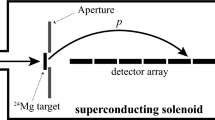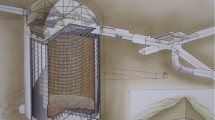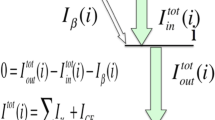Abstract
A very short-baseline neutrino oscillation experiment with an intense 51Cr neutrino source is currently under construction at the Baksan Neutrino Observatory of the Institute for Nuclear Research RAS (BNO). The experiment, which is based on the existing SAGE experiment, will use an upgraded Gallium-Germanium Neutrino Telescope (GGNT) and an artificial 51Cr neutrino source with activity ∼3 MCi to search for transitions of active neutrinos to sterile states with Δm 2 ∼1 eV2. The neutrino source will be placed in the center of a liquid Ga metal target that is divided into two concentric zones, internal and external. The average path length of neutrinos in each zone will be the same and the neutrino capture rate will be measured separately in each zone. The oscillation signature, which comes from the ratio of events in the near and far gallium volumes, will be largely free of systematic errors, such as may occur from cross section and source strength uncertainties, and will provide a clean signal of electron neutrino disappearance into a sterile state at baselines of about 0.6 and 2.0 m. The sensitivity to the disappearance of electron neutrinos is expected to be a few percent. Construction of this set of new facilities, including a two-zone tank for irradiation of 50 tons of Ga metal with the intense 51Cr source, as well as additional modules of the GGNT counting and extraction systems, is close to completion. To check the new facilities they will first be used for SAGE solar neutrino measurements.
Similar content being viewed by others
References
B. M. Pontecorvo, “Neutrino experiments and the problem of conservation of leptonic charge,” J. Exp. Theor. Phys. 53, 1717 (1967).
J. Beringer et al. (Particle Data Group), “Review of Particle Physics (RPP),” Phys. Rev., D 86, 010001 (2012).
A. Aguilar et al. (LSND Collab.), “Evidence for neutrino oscillations from the observation of anti-neutrino(electron) appearance in a anti-neutrino(muon) beam,” Phys. Rev., D 64, 112007 (2002).
A. A. Aguilar-Arevalo et al. (MiniBooNE Collab.), “A search for electron neutrino appearance at the Δm 2 ∼ 1 eV2 scale,” Phys. Rev. Lett. 98, 231801 (2007); “Unexplained excess of electron-like events from a 1-GeV neutrino beam,” Phys. Rev. Lett. 102, 101802 (2009).
A. A. Aguilar-Arevalo et al. (MiniBooNE Collab.), “Improved search for oscillations in the Mini-BooNE experiment,” arXiv:1303.2588v1[hep-ex].
A. A. Aguilar-Arevalo et al. (MiniBooNE Collab.), “Improved search for oscillations in the Miniexperiment,” Phys. Rev. Lett. 110, 161801 (2013).
G. Mention, M. Fechner, Th. Lasserre, et al., “The reactor antineutrino anomaly,” Phys. Rev., D 83, 073006 (2011).
M. A. Acero, C. Giunti, and M. Laveder, “Limits on nu(e) and nu(e)-bar disappearance from Gallium and reactor experiments,” Phys. Rev., D 78, 073009 (2008); C. Giunti and M. Laveder, “Short-baseline electron neutrino disappearance, tritium beta decay and neutrinoless double-beta decay,” Phys. Rev., D 82, 053005 (2010).
K. N. Abazajian, M. A. Acero, S. K. Agarwalla, et al., “Light sterile neutrinos: a White paper, arXiv:1204.5379v1[hep-ph]; V. N. Gavrin, V. V. Gorbachev, E. P. Veretenkin, and B. T. Cleveland, “Gallium experiments with artificial neutrino sources as a tool for investigation of transition to sterile states,” arXiv:1006.2103[nucl-ex].
J. N. Abdurashitov et al. (SAGE Collab.), “Measurement of the solar neutrino capture rate with Gallium metal,” Phys. Rev., C 60, 055801 (1999).
J. N. Abdurashitov et al. (SAGE Collab.), “Solar neutrino flux measurements by the Soviet-American Gallium Experiment (SAGE) for half the 22-year solar cycle,” Zh. Eksp. Teor. Fiz. 122, 211 (2002).
J. N. Abdurashitov et al. (SAGE Collab.), “Measurement of the solar neutrino capture rate with Gallium metal, III: Results for the 2002–2007 data-taking period,” Phys. Rev., C 80, 015807 (2009).
V. N. Gavrin, “The Russian-American Gallium Experiment SAGE,” UFN 0181, 0975 (2011).
A. I. Abazov et al. (SAGE Collab.), “Search for neutrinos from Sun using the reaction 71Ga(νe, e−)71Ge,” Phys. Rev. Lett. 67, 3332 (1991).
P. Anselmann et al. (Gallex Collab.), “Solar neutrinos observed by GALLEX at Gran Sasso,” Phys. Lett., B 285, 376 (1992).
J. N. Abdurashitov et al. (SAGE Collab.), Phys. Rev., C 59, 2246 (1999).
J. N. Abdurashitov et al. (SAGE Collab.), Phys. Rev., C 73, 045805 (2006).
W. Hampel et al. (Gallex Collab.), “Final results of the Cr-51 neutrino source experiments in GALLEX,” Phys. Lett., B 420, 114 (1998).
F. Kaether et al. (Gallex Collab.), “Reanalysis of the GALLEX solar neutrino flux and source experiments,” Phys. Lett., B 685, 47 (2010).
J. N. Bahcall, “Gallium solar neutrino experiments: absorption cross-sections, neutrino spectra, and predicted event rates,” Phys. Rev., C 56, 3391 (1997).
N. Hata and W. Haxton, “Implications of the GALLEX source experiment for the solar neutrino problem,” Phys. Lett., B 353, 422.
D. Frekers, H. Ejiri, H. Akimune, et al., “The Ga-71(He-3, t) reaction and the low-energy neutrino response,” Phys. Lett., B 706, 134 (2011).
D. Frekers, M. C. Simon, C. Andreoiu, et al., “Penning-trap Q-value determination of the 71Ga(ν, e)71Ge reaction using threshold charge breeding of on-line produced isotopes,” Phys. Lett., B 722, 233 (2013).
Author information
Authors and Affiliations
Corresponding author
Additional information
The article is published in the original.
Rights and permissions
About this article
Cite this article
Gavrin, V., Cleveland, B., Danshin, S. et al. Current status of new SAGE project with 51Cr neutrino source. Phys. Part. Nuclei 46, 131–137 (2015). https://doi.org/10.1134/S1063779615020100
Published:
Issue Date:
DOI: https://doi.org/10.1134/S1063779615020100




